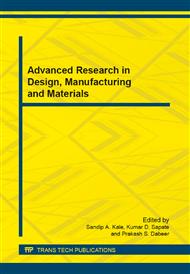[1]
Argun M. E., Dursun S., Ozdemir, C., Karatan, M.; "Heavy metal adsorption by modified Oak saw dust: Thermodynamics and Kinetics", J. Hazardous Materials, 141(2007) 77-85
DOI: 10.1016/j.jhazmat.2006.06.095
Google Scholar
[2]
Bailey S. E., Olin T. J., Bricker R. M., Adrin D. D.; "A review of potentially low-cost sorbents for heavy metals", Water Res. 33, (1999) 2469-2479
DOI: 10.1016/s0043-1354(98)00475-8
Google Scholar
[3]
Benjamin M. M., Lackie J. O.; "Effect of complexation by chloride, solphate and thiosolphate on adsorption behavior of cadmium on oxide surfaces", Environ. Sci. Technol. 16, (1982) 162-170
DOI: 10.1021/es00097a008
Google Scholar
[4]
Chanah T.G., Jumasaiah A., Azni I., Katyon S., Choong, S.Y.T.; "Rice husk as a potential low-cost biosorbents for heavy metal and dye removal: an overview", Desalivation, 175(2005)305-316
DOI: 10.1016/j.desal.2004.10.014
Google Scholar
[5]
Crusberg T. C., Weathers P. J., Baker E. F.; Innovative Hazard Waste Treat.Technol. Ser. 3, (1991)91-96
Google Scholar
[6]
Dakiky M., Khamis M., Manassra A., Mereb M.; "Selective adsorption of Cr (VI) in industrial waster water using low-cost abundantly available adsorbents", Adv. Environ. Res. 6, (2002)533-540
DOI: 10.1016/s1093-0191(01)00079-x
Google Scholar
[7]
Gaballah I., Kilbertusm G.; "Recovery of heavy metal ions through decontamination of synthetic solutions and industrial effluents using modified barks", J. Geochem. Explor. 62, (1998)241-286
DOI: 10.1016/s0375-6742(97)00068-x
Google Scholar
[8]
8.Leyva R. R., Juarez M. A., and Guerrero CRM., "Adsorption of Cr(VI) from aqueous solution on activated carbon", Water science Technology 30, (1994)191-197
Google Scholar
[9]
Lo S. L., and Lin C. Y.; "Adsorption of Heavy metals from wastewater with waste activated sludge", J. Chin. Inst, Eng., 12, (1989)451-461
DOI: 10.1080/02533839.1989.9677182
Google Scholar
[10]
Panchanadikar V. V., Das R. P.; "Biosorption process for removing Pb (II) ions from aqueous effluent using Pseudomonas Sp", Int. J. Environ. Stud. 46, (1994)243-25
DOI: 10.1080/00207239408710929
Google Scholar
[11]
Schindler P. W.; Surface complex at oxide water interface in adsorption of inorganic at solid-liquid interface, (eds. Anderson, M. A. and Rubion, A. J) Ann Arbor science Ann Arbor, Michigan (1981)
Google Scholar
[12]
Toley C. A., Marshall W. E., Johus M. M.; "Granular activated carbons from nutshells for the uptake of metals and organic compounds", Carbon 35, (1997)1407-1414
DOI: 10.1016/s0008-6223(97)00073-0
Google Scholar
[13]
Vogel A. I., 'Quantitative Inorganic Analysis', ELBS, Longmans, London,(1961)435
Google Scholar
[14]
Zhao N., Wei N., Li J., Qiao Z., Cui J., He F., 'Surface properties of chemically modified activated carbons for adsorption rate of Cr(VI)', Chem. Eng. J. 115, (2005)133-138
DOI: 10.1016/j.cej.2005.09.017
Google Scholar


